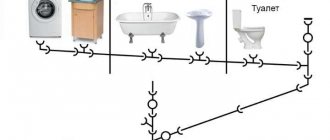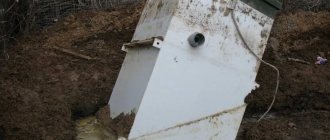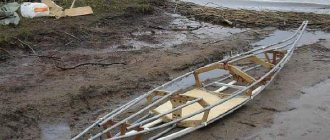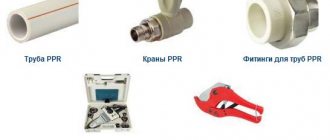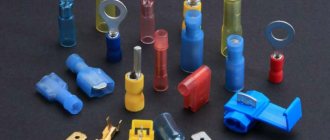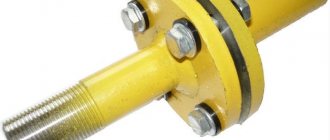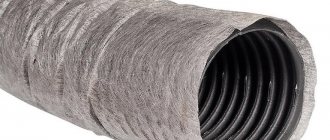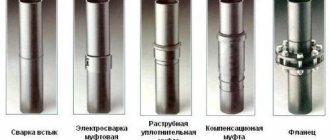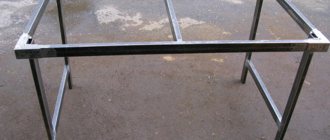One of the most important components of building a house on a country site is protecting the foundation from the negative effects of groundwater. To create a drainage system, perforated plastic products are now most often used, which perform their functions well. Among them, the most popular is a drainage pipe in geotextiles.
Video review of the Softrock drainage system. What it is?
Softrock is not just drainage pipes, but systems that are completely ready for installation, allowing you to reduce the volume and complexity of work when installing drainage. What is included in the drainage and distribution system:
✔ flexible perforated pipes surrounded by polystyrene foam filler;
✔woven geotextile mesh in which this filler is wrapped;
✔connecting couplings and clamps, which are purchased additionally, are used for fastening drainage pipes.
Three-meter blocks consist of pipes with different internal diameters. The result is a structure that is 20–50% more efficient than analogs that use ordinary crushed stone.
SoftRock drainage has the following characteristics:
- pipe diameter – 110, 160, 200 mm;
- outer diameter of the pipe (surrounded by filler) – 300 mm;
- hardness class – 4 SN;
- pipe length – 3 m.
The foam tubules are designed in such a way that they improve the flow of fluids in the drainage system. Siltation is excluded due to the use of geotextile mesh.
How to make drainage in an area without pipes
Ditch preparation
Before making drainage without the use of pipes, it is necessary to draw up a geodetic plan of the site with marked areas of high ground and low ground. These sections will determine the direction of the trench lines, since drainage without pipes should begin at the highest point of the relief and end at the lowest. The drainage system layout should consist of: a central conductor with a depth of at least 50 cm, drainage drains at a distance of 7-10 meters from each other, as well as a water storage tank if it is not discharged by the system outside the site.
A trench is dug at an angle that coincides with the direction of the drainage. The bottom of the recess should be made semicircular, like a gutter.
The ditches are cleared of debris and dirt, after which the bottom is lined with tecton. Geotextiles are laid on top inside the ditch so that the bottom and side walls are completely covered with a margin of at least 20-30 cm. After this, crushed stone is poured and covered with geotextile fabric with an overlap of at least 30 cm. Sand is poured on top of the crushed stone and thoroughly compacted. You can lay turf on a sandy surface or use a geogrid or geogrid if the trench site is located in an area with a high load on the soil.
Soil drainage without the use of waterproofing materials is done in a similar way, but has fewer advantages. Soft drainage with the laying of geotextiles and tecton not only removes water from the site, but also filters it, allowing it to be used in the future as process water or for watering plantings.
What benefits will you get if you buy Softrock rather than a traditional crushed stone system?
Install it yourself - quickly and inexpensively!
Due to the low weight and flexibility of the product, installation is simple, straightforward and can be done by one person. The main thing is to provide a place where the water will drain. It is advisable to lay sand outside the drainage, especially if the soil is clayey. The fact is that such soil is waterproof and needs to be backfilled with sand or black soil, which in turn allows moisture to pass through well.
Increase your drainage efficiency by 40%!
There will be no standing water on your site! Thanks to the geosynthetic filler, it will flow freely into the drainage pipes.
Use drainage with outstanding performance!
The softrock can withstand the weight of 2.5 meters of earth and will not collapse if a car weighing up to 25 tons passes on top. The system lasts up to 100 years, is resistant to cold and freezing, and is perfectly adapted to the climatic conditions of Russia. The closed design is extremely reliable - it resists blockages, siltation and can be reused.
Save on the use of expensive special equipment!
For installation you do not need to use special equipment, because you can do the work yourself. You can transport pipes using a GAZelle, which can accommodate 120–140 linear meters of pipe, or a truck, which can accommodate 1,000 linear meters at once.
Keep your property looking impeccable!
During installation, there will be no dirt, rubble or heavy equipment on the site, which means that the lawn or landscape will not be damaged.
Get the best quality at an affordable price!
The price of pipes with a diameter of 110 mm (they are in greatest demand) and Russian-made filler is from 330 rubles per meter. Make sure that high quality and uninterrupted functionality don't have to be expensive!
Buying Softrock is a much more profitable solution than purchasing conventional pipes. You save on hiring a team of craftsmen, installation and delivery of equipment. In addition, there is no need to buy crushed stone, and its cost can reach 1/3 of the price of the entire system.
Comparison of installation costs for a classic scheme using gravel and sand and the SoftRock drainage system
| Materials | Cost of materials for installation of 1 linear meter with classic drainage | Cost of 1 linear meter of SoftRock |
| Crushed stone | 374 rub. (1 m3 = 1870 rub.) | 450 rub. |
| Sand | 270 rub. (1 m3 = 1350 rub.) | |
| Drain pipe | 80 rub. (1 m = 80 rub.) | |
| Geotectile | 30 rub. (1 m = 30 rub.) | |
| Total: | 754 rub. | 450 rub. |
| Add. expenses (special equipment - installation) | 12,000 rub. | Not required |
| Add. expenses (special equipment - delivery of crushed stone) | from 3500 rub. | Not required |
| Add. expenses (special equipment - sand delivery) | from 3,500 rub. | Not required |
| Taking into account all expenses: | more than 20,000 rub. | 450 rub. linear m. |
Soft drainage without crushed stone
Drainage without the use of pipes can also be carried out without the use of crushed stone, since, depending on the depth of the trenches, its quantity is sometimes very large and expensive. One of these methods is fascine drainage: birch, coniferous, or oak brushwood, tied in bundles 30 cm long, is laid at the bottom of the trenches. Crossed pegs are laid along the entire length of the trench, and brushwood (fascine) is placed underneath them. Sand is poured on top.
Instead of crushed stone, it is also advisable to use expanded clay to arrange a wall drainage system around the house. Its main advantage is low thermal conductivity, due to which it performs a heat-insulating function. A closed method of soil drainage involves using backfill material - pieces of brick, small stones, concrete fragments. The entire trench is filled with these materials, but without the use of geotextiles such a ditch very quickly silts up.
Using ordinary plastic bottles is an alternative to crushed stone and fascines, a simple and budget option. To implement such a drainage system, bottles with screwed caps are placed along the trench at the bottom. Turf is laid on top and sprinkled with earth. Drainage occurs in the space between the bottles.
Another alternative method involves the use of poles. Long branches are laid at the bottom of the trench on spacers made of wooden sticks. The poles must be made of coniferous wood, previously cleared of bark.
The last two described methods of site drainage are unpredictable in terms of service life and operational efficiency, but they are the best options when there are not enough funds for laying drainage from pipes or crushed stone.
Types and features of filler
Filler "Russia"
Styrofoam:
- Cheap. Save about 40%!
- Short-lived. Polystyrene foam is a porous material; moisture is retained in the pores, which freezes at sub-zero temperatures, which leads to the destruction of the filler.
Filler "Import"
Special polystyrene:
- Reliable. Service life up to 100 years!
- It is successfully used in Canada - in climatic conditions similar to Russian ones.
Dornit: non-woven geotextile for wide applications
One of the geofabric options that is widely represented on the market today is dornite. This is the name given to a fabric made from polymer raw materials and used in the construction industry for filtration, reinforcement and as drainage. At first glance, dornite is not much different from ordinary geotextiles, however, this is not so.
The technical characteristics of Dornit geotextiles are in many ways superior to other similar materials, primarily due to the method used in the process of its production. Needle-punched heat-treated geotextiles are capable of withstanding loads that significantly exceed those permissible for conventional materials.
Synthetic geotextiles.
Non-woven needle-punched geotextiles are produced using a special technology, which improves the quality characteristics of the material. This made it possible to use it in many areas. For example:
- in the construction of railways and roads;
- for laying pipelines;
- as a base for laying paving slabs;
- for equipping flat areas for parking.
Having found its place in many areas, dornite helps to successfully solve the following problems: increasing the strength of structures, separating layers of soil and drainage, filtration and prevention of soil leaching processes, protecting drainage systems from pollution.
Geotextiles are a common material used in the construction of industrial and residential facilities, including when laying roads.
SoftRock demonstrates excellent functionality in many areas
✔ For the foundation The task of the drainage and distribution system is to prevent water from entering the base of the object. Drainage is installed at a distance of 0.45 m from the ground surface, along the outer wall of the foundation. In this case, the water is “intercepted” and discharged into the sewer, which is located below and equipped with an internal pipe.
✔ For basements Drainage is carried out to a discharge point or well, after which the moisture is removed by a pump. As a rule, such systems are installed in trenches whose width is about 30 cm.
✔ As a septic tank As one of the elements of a septic tank, Softrock is a set of pipelines with drain holes, which is laid at a depth of no more than 2 m.
✔ For roof drains Melt water is drained away from the foundation or retaining walls of the building. There are two options for removing moisture - underground and surface.
You can learn more about prices and delivery conditions from the managers if you call us at one of the phone numbers listed at the top of each page of the site or in the Contacts section.
- Related products
- Additional products
- Similar products
Which side to lay geotextiles
Another important question that arises during the work process is which side to lay geotextiles on? Even experts have divided opinions here. Some of them argue that there is no significant difference, and the fact that one side is rough and the other smooth is just a cost of production. Reviews claim that no matter which side the material is laid on, the characteristics of geotextiles remain unchanged.
Some manufacturers emphasize to consumers that geofabric should be laid with the smooth side down. In this case, recommendations on which side to lay geotextiles in the drainage will definitely be contained on the product packaging.
The use of geotextiles can increase the efficiency and durability of drainage systems.
Another opinion regarding the question of which side to lay geotextiles suggests using a rough surface for better adhesion to the ground.
In any case, when deciding which side to lay geotextiles on the ground, it is best to listen to the instructions of the manufacturer of the drainage geotextiles you decide to buy.

